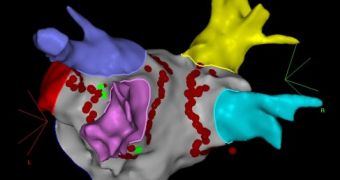A University of Leicester researcher will be carrying out a pioneering intervention, tomorrow, at Glenfield Hospital in Leicester – the world's first remote heart procedure using a robotic arm and 3-D mapping.
Tomorrow, November 16, 2010, Dr Ng, a senior lecturer at the University of Leicester and consultant cardiologist and electrophysiologist at Glenfield Hospital, will be carrying out the first catheter ablation that uses a robot arm along with very advanced 3D mapping, in order to fix an irregular heart rhythm called atrial fibrillation (AF).
Catheter ablation is used quite frequently now, on patients with AF, but the problem is that the procedure carried out by hand can take several hours and the results are not 100% certain.
And as the patient will be a 63 year-old man from Alvaston in Derby, the robotic system is the best way to carry on the procedure.
Glenfield Hospital started performing ablations for AF in 2002, on 25 patients, and reached the steady figure of 200 interventions in 2009.
The procedure consists in inserting thin wire catheters into the inguen and up to the heart.
Once there, the electrodes on the catheters identify the cause of the heart rhythm problem, and the doctor ablates or 'burns' the faulty tissue.
AF affects over half a million people in the UK, increasing the risk of stroke by five times and doubling the risk of death.
It is the most common heart rhythm disturbance seen in clinical practice, and catheter ablation has been used over the past twenty years, to effectively cure AF and other abnormal heart rhythms.
The new procedure that will be carried out tomorrow, comes half a year after Dr Ng carried out the world's first remote catheter ablation procedure using the Amigo Robotic Catheter System.
Dr Ng and his team worked on the development of this robotic arm system and the first experience has proved that the doctor can use it to move catheters by remote control from an adjacent room, thus avoiding the X-ray zone, reducing the radiation exposure and making the heavy lead aprons useless.
The Doctor, with the support of the University of Leicester and the Leicester Cardiovascular Biomedical Research Unit, will lead two clinical research trials at Glenfield, to test the safety and efficacy of the Amigo system in electrophysiology and ablation procedures.
“The new Amigo robotic system we have at Glenfield is unique and a new improved version of the original system which can now be used with different types of catheters, especially allowing the combination with the CARTO-3 3D mapping system,” said Dr Ng.
“CARTO-3 is the latest version of the established and widely used advanced mapping and navigation system which displays and guides precise location of catheter positions in 3D space.
“We are the first center in the world to use this new Amigo system and hence the first to be able to combine the two cutting edge technologies together for the ablation procedure.”
Dr Ng explained that “the initial experience with using the Amigo system suggests that great precision of catheter movement can be achieved using robotic control.
“Combining this for the first time with the accuracy of placing ablation lesions with the CARTO-3 3D mapping system is a significant way forward.
“It is hoped that using the two advanced technologies together would improve the efficacy and safety of these complex procedures.
“The versatility of the new Amigo system also allows for cross-platform use of different types of catheters and different mapping systems which greatly enhance treatment options,” he added.
We wish the 63 year-old man from Alvaston who will undergo the procedure “good luck for tomorrow!”

 14 DAY TRIAL //
14 DAY TRIAL //